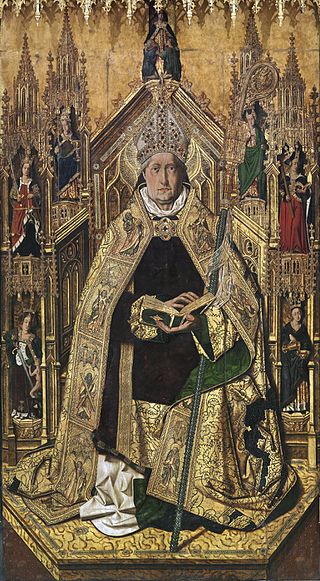
Abbot is an ecclesiastical title given to the head of an independent monastery for men in various Western Christian traditions. The name is derived from abba, the Aramaic form of the Hebrew ab, and means "father". The female equivalent is abbess.

St Benet's Abbey, also known as St Benet's at Holme or St Benet Hulme, was a medieval monastery of the Order of Saint Benedict situated at Cow Holm in Horning, Norfolk, England. It lay on the River Bure within the Broads. St Benet is a medieval English version of the name of St Benedict of Nursia, hailed as the founder of western monasticism. At the period of the Dissolution of the Monasteries the abbey's possessions were in effect seized by the crown and assigned to the diocese of Norwich. Though the monastery was supposed to continue as a community, within a few years at least the monks had dispersed. Today there remain only ruins.

Auxerre is the capital (prefecture) of the Yonne department and the fourth-largest city in the Burgundy historical region southeast of Paris. Auxerre's population today is about 35,000; the urban area comprises roughly 113,000 inhabitants. Residents of Auxerre are referred to as Auxerrois.

Odo of Cluny was the second abbot of Cluny.

Hugh Faringdon,, earlier known as Hugh Cook, later as Hugh Cook alias Faringdon and Hugh Cook of Faringdon, was an English Benedictine monk who presided as the last Abbot of Reading Abbey in the town of Reading in Berkshire, England. At the dissolution of the monasteries under King Henry VIII of England, Faringdon was accused of high treason and executed. He was declared a martyr and beatified by the Catholic Church in 1895.

March 29 - Eastern Orthodox liturgical calendar - March 31

Pontigny Abbey, the church of which in recent decades has also been the cathedral of the Mission de France, otherwise the Territorial Prelature of Pontigny, was a Cistercian monastery located in Pontigny on the River Serein, in the present diocese of Sens and department of Yonne, Burgundy, France. Founded in 1114, it was the second of the four great daughter houses of Cîteaux Abbey. It was suppressed in 1791 in the French Revolution and destroyed except for the church. In 1843 it was re-founded as a community of the Fathers of St. Edmund. In 1909 it passed into private ownership. In 1941 it became the mother house of the Mission de France, a territorial prelature.
Hugh the Abbot was a member of the Welf family, a son of Conrad I of Auxerre and Adelaide. After his father's death, his mother apparently married Robert the Strong, the margrave of Neustria. On Robert's death in 866, Hugh became the regent and guardian for Robert's sons, Odo and Robert.

Amator(in French)Amadour or Amatre was bishop of Auxerre from 388 until his death on 1 May 418 and venerated as a saint in the Catholic Church. Amator's feast day is celebrated on 1 May.
Rodulfus, was an 11th-century Benedictine chronicler.
Ælfric of Abingdon was a late 10th-century Archbishop of Canterbury. He previously held the offices of abbot of St Albans Abbey and Bishop of Ramsbury, as well as likely being the abbot of Abingdon Abbey. After his election to Canterbury, he continued to hold the bishopric of Ramsbury along with the archbishopric of Canterbury until his death in 1005. Ælfric may have altered the composition of Canterbury's cathedral chapter by changing the clergy serving in the cathedral from secular clergy to monks. In his will he left a ship to King Æthelred II of England as well as more ships to other legatees.

The Abbey of Saint Maurice, Agaunum is a Swiss monastery of canons regular in Saint-Maurice, Canton of Valais, which dates from the 6th century. It is situated against a cliff in a section of the road between Geneva and the Simplon Pass. The abbey itself is a territorial abbacy and not part of any diocese. It is best known for its connection to the martyrdom of the Theban Legion, its original practice of perpetual psalmody, and a collection of art and antiquity.

The Archdiocese of Sens and Auxerre is a Latin archdiocese of the Catholic Church in France. The archdiocese comprises the department of Yonne, which is in the region of Burgundy. Traditionally established in sub-apostolic times, the diocese as metropolis of Quarta Lugdunensis subsequently achieved metropolitical status. For a time, the archbishop of Sens held the title "primate of the Gauls and Germania". Until 1622, the metropolitan archdiocese numbered seven suffragan (subordinate) dioceses: the dioceses of Chartres, Auxerre, Meaux, Paris, Orléans, Nevers and Troyes, which inspired the acronym CAMPONT. The Diocese of Bethléem at Clamecy was also dependent on the metropolitan see of Sens. On December 8, 2002, as part of a general reorganization of the dioceses of France undertaken, at least in part, to respond to demographic changes, the Archdiocese of Sens-Auxerre ceased to have metropolitan rank and became a suffragan of the Archdiocese of Dijon, which became the centre of a new ecclesiastical province for the Burgundy administrative region.

The Abbey of Saint-Germain d'Auxerre is a former Benedictine monastery in central France, dedicated to its founder Saint Germain of Auxerre, the bishop of Auxerre, who died in 448. It was founded on the site of an oratory built by Germanus in honor of Saint Maurice.
Abbo of Auxerre was a Benedictine abbot and bishop of Auxerre.

Prinknash Abbey is a Roman Catholic monastery in the Vale of Gloucester in the Diocese of Clifton, near the village of Cranham. It belongs to the English Province of the Subiaco Cassinese Congregation, which is itself part of the worldwide Benedictine Confederation. It is noted for its manufacturing of incense.

The Abbey of St. Marianus was a Benedictine, later Premonstratensian, monastery in Auxerre in the French department of Yonne in Burgundy. Established in the fifth century, it was the first monastery established in the diocese.
Saint Marianus of Auxerre was a monk of Auxerre in Yonne, France. He was considered a saint because of the sanctity of his life and is invoked as a protector of animals. His feast day is 20 April.

The Forterre is a small natural region on the western edge of the French region of Bourgogne-Franche-Comté.














